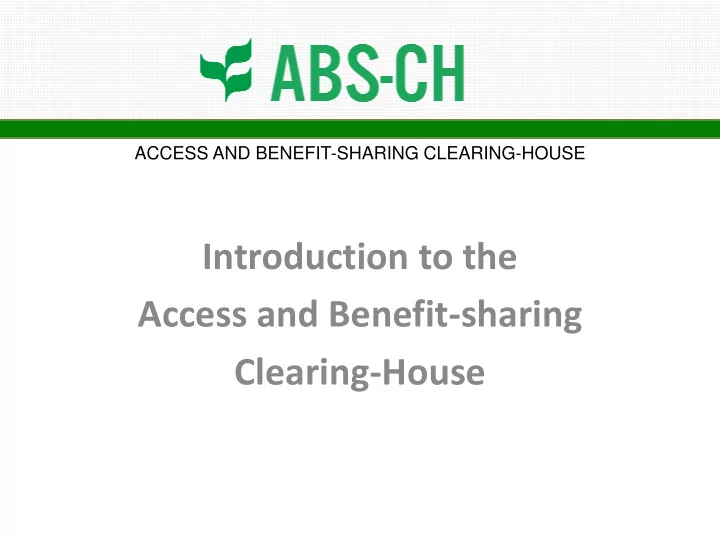

ACCESS AND BENEFIT-SHARING CLEARING-HOUSE Introduction to the Access and Benefit-sharing Clearing-House
Article 14 Establishes the ABS-CH - as part of the CHM Main function - to facilitate the exchange of ABS relevant information
Article 14 The main information that is to be shared: 1. ABS Measures 2. NFPs 3. CNAs 4. Permits and their equivalent (IRCC)
Facilitate exchange of relevant information Facilitate the implementation of the NP The goal of the ABS-CH ✓ Access : legal certainty, clarity, transparency on how to access GR and TK ✓ Benefit-sharing : opportunities for ABS agreements ✓ Compliance : monitoring the use of GR
How does the ABS-CH function?
Registering functions - Standardized publishing procedure to ensure reliability of information made available through the ABS Clearing-House - Use of common formats and controlled vocabulary for submission of information with a view to facilitating consistent and harmonized searches in different languages - Possible submission online and offline
Common Formats: Two categories of ABS records National Records • Legislative, administrative and policy measures on ABS • Competent National Authority/ies • National ABS Website or Database • Permit or its equivalent constituting an internationally recognized certificate of compliance (Article 17.2) • Checkpoint (Article 17.1(a)) • Checkpoint Communiqué (Article 17.1 (a)(iii)) • In progress: Interim national report (Article 29) Reference Records • Virtual Library Resource • In progress: Article 19 and 20 tools • In progress: Community protocols and customary laws
Common Formats: Two publishing procedures ABS-CH National Records Public Approved by Drafted by national publishing Published authorized users authority Information Related to ABS View records Reference Records Search Aggregate Information Country profiles Drafted by any Approved by Registered User SCBD
How can I contribute to the ABS-CH? How can I benefit from the ABS-CH?
Governments: By publishing national information on the ABS-CH, Parties and other governments help: • Users : Find the information they need to access genetic resources and associated TK • Providers : Find the necessary tools to monitor the utilization of these resources By providing reliable information, the ABS-CH creates opportunities for the development of ABS agreements and the sharing of benefits Non-Parties are encouraged to share all relevant ABS information through the ABS-CH
Private sector and research institutions Find reliable and up-to-date information on how to access GR and TK in the country profiles • Can contribute to the ABS-CH by sharing model contractual clauses, codes of conduct, guidelines and best practices and access resources shared by others
Indigenous and local communities • Can use the ABS-CH to share information on how to access TK: • Community protocols, customary laws and procedures, model contractual clauses and competent authorities of ILCs Providing information will increase the opportunities for the development of ABS agreements and the sharing of benefits • Can access and contribute to the ABS-CH with awareness- raising and capacity building materials on the Nagoya Protocol in their own indigenous languages
International and non-governmental organizations and others • Can share information through the Virtual Library: (e.g brochures, toolkits, publications, booklets and learning modules) The ABS-CH can become a central hub of information related to capacity-building, including initiatives and tools and resources.
Participate The ABS-CH will not work without the active participation of Parties and others Register information: • Country: nominate a publishing authority • Other users: register for a CH account Search information: No need of an account for searching information in the ABS-CH
Common formats for capacity-building
• Common formats have been developed for sharing information on the ABS-CH, CHM and BCH. • There is a set of information which is common to all platforms • There is a specific information for each of the exchange mechanisms. • Make use of agreed controlled vocabulary applied consistently throughout the different common formats and exchange mechanisms. • Reference records • Any registered user with a CH account can submit information • Secretariat approves the records
Process forward: • IAC-CB: Advice to the ES from the CB perspective • IAC to the ABS-CH and the CHM will jointly provide guidance to the ES on resolution of technical and practical issues (30 October 2015) • The ES will revise the common formats taking into account guidance received as well as technical requirements for ensuring coherence and compatibility between common formats and CBD exchange mechanisms • The ES to implement the common formats online and display and analysis of information. • The ES to analyze information received for COP-MOP- 2
How to ensure that the ABS-CH becomes a reliable source of information on capacity- building? • Need the participation of countries, ILCs, organizations, and other stakeholders to populate the ABS-CH. • The SCBD offers technical support for submitting information in the ABS-CH (webinar, helpdesk, personalized technical support, guidance materials)
Recommend
More recommend